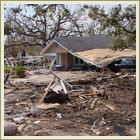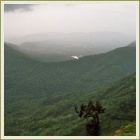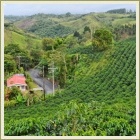|
 |
Subscribe to the Research Digest
or Read Online |
|
|
|
|
Managing Climate Change Risk
New data pointing to the inevitable collapse of the West Antarctic Ice Sheet - and major implications for sea level rise - underscore the urgent message at
the heart of a recent United Nations report. We can manage some of the risks from global warming if we make preparations now, according to "Climate Change 2014: Impacts,
Adaptation and Vulnerability," an Intergovernmental Panel on Climate Change (IPCC) report with its administrative headquarters at Stanford. It presents a wealth of data not only
on climate impacts, but also on adaptation options such as resilient infrastructure and risk-sharing economic instruments. "Even though we face some serious challenges, we have
some really attractive opportunities for building a better world in the future," said Stanford Woods Institute Senior Fellow Chris Field (Biology, Environmental Earth System Science), co-chair of the working group that produced the report. The authors and editors of the analysis include Woods Senior
Fellows Noah Diffenbaugh (Environmental Earth System Science), David Lobell (Environmental Earth System Science) and Terry Root (Biology, by
courtesy). Another recent IPCC report, focused on climate change mitigation, included several Stanford professors as writers and editors.
Read more and watch video...
Read on for more insights and discoveries on environmental challenges and solutions published by Stanford
Woods Institute fellows and affiliated
researchers. We invite you to subscribe to this quarterly Research Digest, as well as our monthly newsletter.
|
|
|
|
|
 |
 |
Learning to Live in a Time of Change
The future is now. That was the news at the heart of the recently released National Climate Assessment, which details
climate change impacts - from increases in extreme heat and droughts to more polluted air and the spread of mosquito-borne viruses - already under way around the U.S. More than 300
experts, including Woods-affiliated Professor of Management Science and Engineering John Weyant, Consulting Professor Mary Ruckelshaus (Natural Capital Project) and Social Science
Research Fellow Susanne Moser (Center for Ocean Solutions),
compiled the assessment. Its extensive data and
online multimedia tools, including video chapter summaries, can
empower decision-makers with the regional and economic information they need to make wise adaptation choices.
Read more, watch video and explore graphics...
"National Climate Assessment," May 6, 2014
|
 |
Extremes in Wet, Dry Spells Increasing for South Asian Monsoons
Stanford scientists have identified significant changes in the patterns of extreme wet and dry events that are increasing the risk of drought and flood in central India, one of the
most densely populated regions on Earth. The discoveries are the result of a new
collaboration between climate scientists, including Senior Fellow Noah
Diffenbaugh (Environmental Earth System Science) and statisticians that focused on utilizing statistical methods for analyzing rare geophysical events. These new
approaches reveal that the intensity of extremely wet spells
and the number of very dry periods during the South Asian monsoon season have both been increasing in recent decades.
Photo credit: Stephane Pasteur
Read more...
"Observed Changes in Extreme Wet and Dry Spells During the South Asian Summer Monsoon Season," Nature Climate Change, April 28, 2014 |
|
More
information about Stanford Woods Institute climate research |
|
 |
 |
Rethinking 'Natural' Habitat for Wildlife
What if agricultural land could double as wildlife habitat? A study co-authored by Senior Fellow Gretchen Daily (Biology) finds that a long-accepted theory used to estimate extinction rates, predict ecological risk and make conservation policy recommendations is overly
pessimistic. The researchers point to another approach, which promises a more effective way of accounting for human-altered landscapes and assessing ecological risks. Their work
questions some long-held beliefs about conservation and holds the promise of ensuring access to many of nature's benefits, such as water purification provided by wetlands and pest
control provided by birds and bats.
Photo credit: Dave Spangenberg
Read more...
"Predicting Biodiversity Change and Averting Collapse in Agricultural Landscapes," Nature, April 16, 2014 |
 |
Tigers: Seeking Exotic Mate
What is the most effective way to ensure that tigers, iconic symbols of power and beauty, continue to roam? A study co-authored by Senior Fellow Elizabeth Hadly (Biology) shows that increasing
genetic diversity among the 3,000 or so wild tigers left on the planet is the key to their survival as a species. But current tiger conservation plans focus only on increasing numbers
and preserving distinct subspecies, while ignoring genetic diversity.
Photo credit: Prasenjeer Yadav
Read more...
"A Call for Tiger Management Using "Reserves" of Genetic Diversity," Journal of Heredity, April 15, 2014
|
|
Other Ecosystem Services and Conservation Research
"Exploring Sense of Place and Environmental Behavior at an Ecoregional Scale in Three Sites," Human Ecology, April 2014, co-authored by Center Fellow Nicole Ardoin (Education)
"Cascading Effects of Insectivorous Birds and Bats in Tropical Coffee Plantations," Ecology, April 2014, co-authored by Senior Fellow Gretchen Daily (Biology)
"Indicators of Soil Fertility and Opportunities for Precontact Agriculture in Kona, Hawaii," Ecosphere, April 2014, co-authored by Senior Fellow Peter Vitousek (Biology)
"Bottom-Up Climate Risk Assessment of Infrastructure Investment in the Niger River Basin," Climate Change. January 2014, co-authored by Woods-affiliated research associate Yonas Ghile (Natural Capital Project)
"The Relationship of Place Re-Making and Watershed Participation in Appalachia," Society and Natural Resources, January 2014, co-authored by Center Fellow Nicole Ardoin (Education)
|
|
More information about Stanford Woods Institute ecosystem services research |
|
 |
 |
As Temperatures Rise, Crop Yields Will Likely Fall
Early adaptation could increase projected crop yields by up to 15 percent, according to a new study co-authored by Senior Fellow and Center on Food Security and the Environment Associate Director David Lobell (Environmental Earth System Science). Lobell and an international team of climate scientists modeled future crop yields under several
global climate scenarios throughout the 21st century. They found that if farmers adapt to climate change within the next few years, they have a better chance of avoiding or even
reversing the predicted decline of wheat and rice yields in some regions.
Photo credit: Scott Bauer
Read more...
"A Meta-Analysis of Crop Yield Under Climate Change and Adaptation," Nature Climate Change, March 16, 2014 |
 |
Chinese Farmers Adapt to Climate Change
Through adaptive approaches such as using longer-maturing varieties, farmers in a northern region of China have seen maize production increase up to 17 percent per decade, according
to a study co-authored by Senior Fellow David Lobell (Environmental Earth System Science). Since 1980, warming has occurred fastest in the earth's northern latitudes, but its effects on agriculture in these regions
remain unclear. The research by Lobell and his colleagues opens a window into related ongoing adaptations and benefits.
Read more...
"The Benefits of Recent Warming for Maize Production in High Latitude China," Climatic Change, January 2014 |
|
More information about Stanford Woods Institute food security research |
|
 |
 |
Report: Addressing the Land Use-Groundwater Link
Groundwater provides about 30 percent of California's water supply during normal years and 40 percent or more in dry years. In many parts of the state, water users are withdrawing
groundwater at unsustainable rates, due in part to land use changes. A report by the Water in the West program offers
suggestions for improving
the linkage between groundwater and land use. Among the recommendations: Make new tools available to communities to allow them flexibility to regulate groundwater demand as land use
changes. The report is based on an "Uncommon Dialogue" that brought together 30 groundwater managers, land use managers, water lawyers, consultants and academics.
Read more...
"Before the Well Runs Dry: Improving the Linkage Between Groundwater and Land Use Planning," April 2014 |
 |
Toward Western Water Sustainability
Water, and the lack thereof, play an outsize role in the history and continued viability of the American West. How can resource managers and other decision-makers most effectively
plan for sustainable and integrated water systems? A survey article co-authored by Water in
the West Research Analyst Janny Choy and Water in the West Executive Director Leon Szeptycki provides insight into how water management in the West is shaped and is shaping the region today
and in the near future. With a particular focus on changes during the past 15 years, the authors examine a range of issues from ecosystem services and climate change preparation to
water markets and water infrastructure financing.
Read more...
"Water in the West," January 29, 2014 |
|
Other Freshwater Research
"Advancement and Validation of Surface Nuclear Magnetic Resonance Spin-Echo Measurements of T2," Geophysics, March 2014, co-authored by Senior Fellow, by courtesy, Rosemary Knight (Geophysics)
"Bootstrap Calibration of Downhole Nuclear Magnetic Resonance Hydraulic Conductivity
Estimates in an Unconsolidated Aquifer," Groundwater, Feb. 12, 2014, co-authored by Senior Fellow, by courtesy, Rosemary Knight (Geophysics)
"Quantifying Background Magnetic Field Inhomogeneity for Improved Interpretation of
Free Induction Decay Measurements," Geophysics, January 2014, co-authored by Senior Fellow, by courtesy, Rosemary Knight (Geophysics)
|
|
More information about Stanford Woods Institute freshwater research |
|
 |
 |
Crude Oil Causes Abnormalities in Tuna
Crude oil from the 2010 Deepwater Horizon disaster causes severe defects in the developing hearts of bluefin and yellowfin tuna, according to a study by a team of National Oceanic and Atmospheric Administration and academic scientists, including Senior
Fellow, by courtesy, Barbara Block (Biology). The findings show how the largest
marine oil spill in United States history may have
affected tunas and other species that spawned in oiled offshore habitats in the northern Gulf of Mexico.
Photo credit: NOAA Fisheries Service
Read more...
"Deepwater Horizon Crude Oil Impacts the Developing Hearts of Large Predatory Pelagic Fish," PNAS, March 24, 2014 |
 |
Unintended Consequences: A Global Map of Fisheries Bycatch
Scientists and resource managers now have a valuable resource at their disposal to better understand the scope of unintentionally harvested sea creatures or bycatch. An analysis co-authored by Senior Fellow Larry Crowder (Biology) provides an unprecedented global map of bycatch, starkly illustrating the scope of the problem and the need to expand existing
conservation efforts in certain
areas.
Photo credit: Larry Crowder
Read more...
"Global Patterns of Marine Mammal, Seabird and Sea Turtle Bycatch Reveal Taxa-Specific and Cumulative Megafauna Hotspots," PNAS, March 17, 2014 |
|
Other Oceans Research
"A 215-Year Coral δ180 Time Series From Palau Records Dynamics of the
West Pacific Warm Pool (WPWP) Following the End of the Little Ice Age (LIA), Coral Reefs," Coral Reefs, April 4, 2014, co-authored by Senior Fellow Rob Dunbar (Environmental Earth System Science)
"Flow Through a Rough, Shallow Reef," Coral Reefs, March 2014, co-
authored by Senior Fellow Stephen Monismith (Civil and Environmental Engineering)
"Fortnightly Tidal Modulations Affect Net Community Production in a Mesotidal
Estuary," Estuaries and Coasts, March 2014, co-authored by Senior Fellow Stephen Monismith (Civil
and Environmental Engineering)
"High Vulnerability of Diversity and Function in Caribbean Coral Reefs," Biological Conservation, March 2014, co-authored by Woods-affiliated Professor of Biological Sciences Fiorenza Micheli and Woods-affiliated postdoctoral scholar Steven Litvin (Hopkins Marine Station)
"Crude Oil Impairs Cardiac Excitation-Contraction
Coupling in Fish," Science, Feb. 14, 2014, co-authored by Senior Fellow, by courtesy, Barbara Block (Biology)
"Long-Range Movement of Humpback Whales and Their Overlap With Anthropogenic Activity
in the South Atlantic Ocean," Conservation Biology, Feb. 5, 2014, co-authored by Woods-affiliated postdoctoral scholar Sara Maxwell (Biology)
"Using Environmental DNA to Census Marine Fishes in a Large
Mesocosm," PLOS ONE, Jan. 15, 2014, co-authored by Senior Fellow Larry
Crowder (Biology) and Woods-affiliated postdoctoral scholars Kevan Yamahara and Jesse Port, both with the Center for Ocean Solutions
"Predicting Bycatch Hotspots for Endangered Leatherback Turtles on Longlines in
the Pacific Ocean," Proceedings of the Royal Society B, Jan. 8, 2014, co-authored by Senior Fellow, by courtesy, Barbara Block (Biology)
"Improved Parameterization of Seagrass Blade Dynamics and Wave Attenuation Based on Numerical and
Laboratory Experiments," Limnology and Oceanography, January 2014, co-authored by Senior Fellow and Woods Co-Director Jeff Koseff (Civil and Environmental Engineering), Woods-affiliated Associate Professor of Civil and Environmental Engineering Oliver Fringer and Woods-affiliated postdoctoral scholar Joel S. Weitzman (Civil and Environmental Engineering)
"Thermal Structure and Variability of a Shallow Tropical Reservoir," Limnology and
Oceanography, January 2014, co-authored by Senior Fellow Stephen Monismith (Civil
and Environmental Engineering)
"Using Depth-Normalized Coordinates to Examine Mass Transport Residual Circulation in Estuaries with Large Tidal Amplitude Relative to the Mean Depth," Journal of Physical Oceanography, January 2014, co-authored by Senior Fellow Stephen Monismith (Civil and Environmental Engineering)
|
|
More information about Stanford Woods Institute oceans research |
|
 |
 |
Watching the Washers
One of the best defenses against infectious disease is one of the most simple: hand washing. Still, despite years of global public awareness campaigns, hand washing rates remain
low. A study co-authored by Higgins-Magid Senior Fellow Senior Fellow Jenna Davis (Civil and Environmental Engineering) and Woods postdoctoral scholar Amy
Pickering (Water, Health and Development) provides insights into hand washing behavior recorded on video. When another
person is present, for example, hand washing rates increase 23 percent. These findings could, in turn, inform the design, monitoring and evaluation of hygiene campaigns.
Photo credit: Amy Pickering
Read more...
"Video Surveillance Captures Student Hand Hygiene Behavior, Reactivity to Observation and Peer Influence in Kenyan Primary Schools," PLOS ONE, March 27, 2014 |
 |
Ticks May Cause Double Trouble
Some people struggling with mysterious illnesses may have a better chance at finding diagnoses, thanks to study co-authored by Dan Salkeld, a Woods research associate. Salkeld and other researchers found a newly recognized human pathogen, Borrelia
miyamotoi, as well as
Borrelia burgdorferi, the bacterium that causes Lyme disease, in ticks they sampled throughout the San Francisco Bay area. The Centers for Disease Control and Prevention
estimate that as many as 300,000 Americans contract Lyme disease annually, a rate 10 times higher than previously reported - a finding that indicates Lyme is not well diagnosed or
reported by many doctors.
Photo credit: Ervic Aquino
Read more...
"Tick-Borne Pathogens in Northwestern California, USA," Emerging Infectious Disease, March 2014 |
|
Other Public Health Research
"Enteric Pathogens in Stored Drinking Water and on Caregiver's Hands in Tanzanian
Households With and Without Reported Cases of Child Diarrhea," PLOS ONE, Jan. 2, 2014, co-authored by Higgins-Magid Senior Fellow Senior Fellow Jenna Davis (Civil and Environmental Engineering), Woods-affiliated Professor of Structural Engineering Alexandria Boehm and Woods
postdoctoral scholar Amy Pickering (Water, Health and Development)
|
|
More information about Stanford Woods Institute public health research |
|
 |
 |
Solar Farms Can Double as Biofuel Crop Farms
Carefully chosen plants amid photovoltaic panels could allow solar farms not only to collect sunlight for electricity but also to produce crops for biofuels, according to computer
model research by Stanford scientists including Senior Fellows Chris Field (Biology, Environmental Earth System Science) and David Lobell
(Environmental Earth System Science). This co-location approach could prove especially useful in sunny, arid regions such as the southwestern United States, where water is scarce.
Photo credit: Courtesy of Sujith Ravi
Read more...
"Tradeoffs and Synergies Between Biofuel Production and Large Solar Infrastructure in Deserts," Environmental Science and Technology, Jan. 27, 2014 |
 |
A Surplus of Reliable Clean Energy
The worldwide demand for solar and wind power continues to skyrocket. At issue is whether renewable energy supplies produce enough energy to fuel both their own growth and the
growth of the storage necessary to deliver clean energy on demand when sunlight and wind are in short supply. For the wind industry, the answer appears to be yes, according to research by a team of Stanford scientists including Sally Benson, a Woods-affiliated professor of energy resources engineering and director of the Global Climate and
Energy Project (GCEP) at Stanford.
Photo credit: Dennis Schroeder/NREL
Read more...
"Can We Afford Storage? A Dynamic Net Energy Analysis of Renewable Electricity Generation Supported by Energy Storage," Energy & Environmental Science, March 19, 2014 |
|
Other Sustainable Development Research
"Taming Hurricanes With Arrays of Offshore Wind Turbines," Nature Climate Change, Feb. 26, 2014, co-authored by Senior Fellow Mark Jacobson (Civil and Environmental Engineering)
"A More Social Science: Barriers and Incentives for Scientists Engaging in Policy," Frontiers in Ecology and the Environment, April 2014, co-authored by Leopold Leadership Program Fellows Thomas D. Sisk and Kai MA Chan
|
|
More information about Stanford Woods Institute sustainable development research |
|
|
|
|
Find Us on the Web
   |
|
The Stanford Woods Institute Research Digest is a quarterly report of findings by Woods fellows and affiliated faculty, as well as fellows with the Institute's Leopold Leadership Program. Current and past issues are online.
Contact us to subscribe or provide information about new and forthcoming research.
To learn more about the Stanford Woods Institute for the Environment, visit our website or email us.
Stanford Woods Institute for the Environment
Jerry Yang & Akiko Yamazaki Environment & Energy Building - MC 4205
473 Via Ortega
Stanford, CA 94305 |
|
|
|
